Citation: Taylor, G. J. (April, 2013) Meteoritic Minerals Tell a Story of Multistage Cooling, Break-up, and Reassembly of an Asteroid. Planetary Science Research Discoveries. http://www.psrd.hawaii.edu/April13/multistage-cooling.html (date accessed).
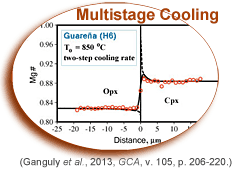 |
April 30, 2013
Meteoritic Minerals Tell a Story of Multistage Cooling, Break-up, and Reassembly of an Asteroid
--- Compositional variations in minerals in H-chondrites indicate at least two vastly different cooling rates at different temperatures, suggesting fragmentation, cooling of the fragments, and reassembly into a second-generation rubble pile.
Written by G. Jeffrey Taylor
Hawai'i Institute of Geophysics and Planetology
By analyzing different pairs of adjacent minerals combined with published age data, Jibamitra Ganguly (University of Arizona) and colleagues at University of Arizona and the Institut für Geohysik (Rühr University, Germany) were able to determine a detailed thermal history of H-chondrites, hence of the asteroid they hail from. They made careful measurements of compositions of mineral thermometers/thermospeedometers, including high- and low-calcium pyroxene, spinel-orthopyroxene, and spinel-olivine. The results show that minerals are compositionally uniform (except very close to the interface between two mineral thermometers, approximately 1-2 micrometers, due to spatial resolution constraints of the electron microprobe). Calculations show that this lack of compositional variation within minerals requires rapid cooling at high temperature (about 750 to 850 degrees Celsius), 25 to 100 degrees Celsius per thousand years. In contrast, previous studies of cooling rates determined from compositional zoning in metallic iron-nickel grains indicate that most rocks cool far slower by the time the temperature dropped to 500 degrees Celsius, typically 10 to 100 degrees Celsius per million years.
This colossal discrepancy is not caused by problems with the cooling rate determinations. Instead, Ganguly and coworkers argue that the difference arose because the H-chondrite parent asteroid was assaulted early in its history, while it was still hot from internal heating. Another asteroid hit it, breaking it into thousands or tens of thousands of fragments. The fragments cooled significantly, but not completely, and then reassembled into a jumbled pile of chondritic rock. The material inside the final rubble pile was able to cool slowly, accounting for the slow cooling at 500 degrees Celsius.
Reference:
- Ganguly, J., Tirone, M., Chakraborty, S., and Domanik, K. (2013) H-Chondrite parent asteroid: A multistage cooling, fragmentation, and re-accretion history constrained by thermometric studies, diffusion kinetic modeling and geochronological data. Geochimica et Cosmochimica Acta, v. 105, p. 206-220, doi: 10.1016/j.gca.2012.11.024. [ abstract ]
- PSRDpresents: Meteoritic Minerals Tell a Story of Multistage Cooling, Break-up, and Reassembly of an Asteroid --Short Slide Summary (with accompanying notes).
Heating, Cooling, Ages, and the Battle over the Onion
Chondrites are rocky meteorites containing abundant millimeter-sized crystallized droplets of molten silicates. The round droplets are called chondrules, from which chondrites get their name. These wee igneous rocks probably formed in the dusty gas cloud surrounding the proto-Sun. Isotopic analyses indicate that chondrules formed up to 3 million years after formation of the first solids in the Solar System.
Formation of chondrules is an interesting and sometimes contentious topic, but the little droplets are also useful indicators of the temperature and duration of heating inside chondrite parent asteroids. Cosmochemists have firmly established that chondrite parent bodies were heated internally by the decay of aluminum-26 (26Al), an isotope with a half-life of only 730,000 years (see PSRD article: An Even More Precise View of Aluminum-26 in the Solar Nebula). Decay of 26Al dumps a lot of heat into an asteroid. In fact, 26Al decay produces heat much faster than it can leave the body by conduction, leading to a hot interior. In the case of differentiated asteroids so much heat was deposited that the temperature rose to the melting point.
Chondrites did not melt, but they were heated enough to cause mineralogical and textural changes in them. The extent of the changes varies, leading to a classification scheme, originally developed by John Wood and Randy Van Schmus in the late 1960s. It begins with type 3 chondrites that were barely affected by the thermal metamorphism: chondrules are distinct with glassy areas inside them, minerals are chemically zoned due to formation by crystallization in chondrules, and abundant, dark, fine-grained matrix material surrounds the chondrules. The classification ends with type 6 in which chondrules are much less distinct because their boundaries have grown together, minerals are generally uniform in composition because diffusion has ironed out the original differences, and the fine-grained matrix has coarsened and exchanged elements with the chondrules. Types 4 and 5 are gradations in this sequence. The figure below illustrates the textural changes that took place during chondrite metamorphism.
 |
| Several investigators over the years have done calculations for the heating and cooling of asteroid-sized bodies (typically 50 to a few hundred kilometers in radius). All results show that the central zone is hotter for longer than regions closer to the surface. Cosmochemists have suggested that type 6 chondrites formed in the central zone, with types 5, 4, and 3 forming progressively closer to the surface (see colored illustration; intensity of red is proportional to temperature). The photomicrographs are of typical chondrites in each petrographic class. Chondrules (round objects clearly visible in the upper-left photograph of a type 3 chondrite) become progressively less visible with metamorphic grade. Glass in the chondrules transforms to mineral crystals, and minerals become chemically homogeneous in the sequence from type 3 to type 6. Different temperatures of metamorphism and different cooling rates almost certainly caused these changes. |
Internal heating by decay of short-lived 26Al inevitably causes the deepest interior to be hotter and hotter for longer than regions closer to the surface. This leads to the concept that type 6 chondrites would have formed deeper than type 5, which would have formed deeper than type 4. Type 3 were heated the least and resided closer to the surface. This view of chondrite parent body metamorphism and thermal structure is called the "onion-shell" model. Because it is a natural consequence of internal heating of asteroid-sized bodies, and it seems so orderly and logical, many meteorite specialists are enchanted with the onion-shell model.
How to Test the Onion-Shell Model
Common thermal sense (and a lot of quantitative calculations of how temperatures inside an internally heated asteroid vary with time) dictate that type 6 chondrites reached the highest temperatures and cooled the slowest, and that the other petrographic types were not heated as much and cooled faster. In addition, the slowest cooled chondrites should have the youngest ages because they remained hotter than the temperature at which isotopic systems freeze in. We should see, therefore, a correlation between peak temperature reached during metamorphism, cooling rate, and petrographic type. These quantitative predictions can be tested by using assorted mineral thermometers and meteorite ages. Check out a detailed list in the PSRD article: Heating, Cooling, and Cratering: One Asteroid's Complicated Story.
Mineral thermometers are based on the compositions of minerals that exchange elements. A classic example is high-calcium and low-calcium pyroxene. As temperature drops decreases, co-existing pyroxenes change the calcium contents: low-calcium ones become lower in calcium while the high-calcium pyroxene crystals become higher in calcium. Low-calcium pyroxene has a different crystal structure (called orthorhombic) than high-calcium pyroxene (monoclinic), leading to characterizing pyroxenes as orthopyroxene and clinopyroxene. The important point is that the two types of pyroxenes exchange elements to maintain equilibrium as temperature changes. Like the other mineral thermometers the two-pyroxene thermometer has been calibrated through extensive laboratory experiments. Others that Jibamitra Ganguly and his colleagues used are iron and magnesian exchange between orthopyroxene and clinopyroxene, orthopyroxene and spinel, and olivine and spinel.
Elements move at different rates, called diffusion rates, in each mineral. This means that at a given cooling rate, exchange of elements effectively stops in some minerals before it does in others. In other words, each mineral pair has a unique temperature at which element exchange stalls, called the closure temperature. This is also true of isotopic exchange between minerals or loss of the decay product from a mineral containing a radioactive element. For example, 40Ar is produced by the decay of 40K inside feldspar crystals. At relatively high temperature, the argon is continuously lost, but begins to be retained at the closure temperature. Of course, closure temperature depends on the size of mineral grains (the distance over which diffusion has to occur) and the cooling rate. Fast cooling leads to higher closure temperature than slow cooling.
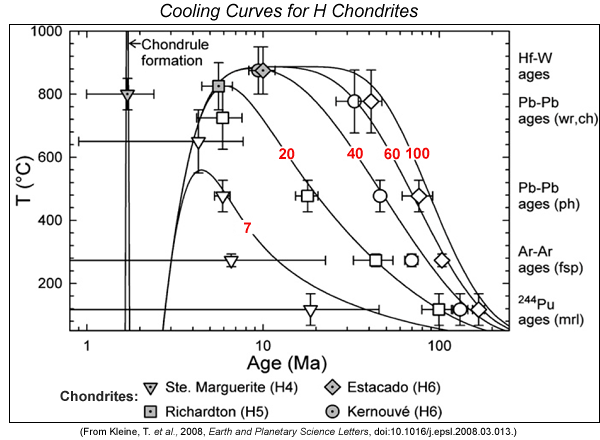 |
| This graph shows cooling curves for an asteroid 100 kilometers in radius, as calculated by Thornsten Kleine. Numbers on the curves (in red) refer to depth from the surface of the asteroid in kilometers. Shorter times mean faster cooling, hence shallower burial. These four chondrites are consistent with the onion shell model for asteroids. Note that the uniform values for the closure temperatures of each isotopic system is an oversimplification because closure temperature is higher for faster cooling and lower for slower cooling. Nevertheless, the general point is valid that the more rapidly-cooled chondrites (the ones that formed closer to the surface) have younger ages. Data points are ages and closure temperatures for different isotopic systems: Hafnium (Hf) decay to tungsten (W), lead-lead (Pb-Pb) ages from decay of uranium and thorium isotopes (done on whole rock, wr, and phosphate mineral separates (ph), argon-argon (Ar-Ar) which is based on 40K decay to 4040Ar, and fission track retention ages (244Pu), which is based on natural fission of radioactive plutonium-244. The curves are based on numerical models of asteroid heating and cooling. |
Test Results: Discombobulated Onions
Jibamitra Ganguly and his colleagues analyzed adjacent mineral pairs using an electron microprobe, then quantified the cooling rates required to match the compositional profiles. One example of the results is shown in the diagram below, for the H6 chondrite Guareña [ Data link from the Meteoritical Bulletin ]. It focuses only on the variation in magnesium (Mg) and iron (Fe) in orthopyroxene and clinopyroxene crystals next to each other, expressed by the Mg/(Mg+Fe) ratio (abbreviated Mg#), although other pairs were also analyzed. Understanding the cooling history comes in four steps (see diagram below).
Step 1: Measure the compositions of adjacent minerals. The Mg# is uniform inside each type of pyroxene, as shown by the data points forming flat lines inside each mineral. The data points represent individual electron microprobe measurements using a beam one micrometer in diameter, spaced 1 micrometer apart. Orthopyroxene and clinopyroxene compositions, although uniform within each mineral, are different from each other, reflecting their different crystal-chemical makeup. The most interesting feature of this diagram is that there is essentially no measurable chemical variation at the boundary between the two minerals (shown by the vertical lines on the graphs below). One point straddles the compositional range, which with a beam only one micrometer across indicates very little transport of Fe and Mg took place between these two minerals. These data and the calcium concentrations indicate a peak temperature for metamorphism of Guareña of 848 (±5 oC). Diffusion is relatively fast at a temperature that high, so the minimal chemical variation near the edges of each mineral indicates that cooling must have been rapid, at least when the temperature was high. This led Jibamitra Ganguly and colleagues to try to quantify the cooling rate.
Step 2: Determine the cooling rate at high temperature. Using of numerical solutions to classic diffusion equations and diffusion rates determined by experiments, Ganguly and colleagues calculated the compositional profiles expected in chondrites cooling from some starting temperature at assorted rates. The initial temperature was determined by the temperature recorded by the orthopyroxene-clinopyroxene pairs, which have the highest closure temperatures. Two examples of the calculations appear in the graphs below, compared to the same data for two adjacent pyroxene grains as measured by Ganguly. The best match is for a cooling rate of 100 degrees Celsius per thousand years (100 oC/ky), or 0.1 degrees/year. For comparison, the curves for a slower rate, 25 oC/ky are also shown in the graph. The slower rate clearly deviates from the data points near the boundary between the two grains of pyroxene analyzed. The calculations show that Guareña must have cooled from an initial temperature around 850 oC at a relatively fast rate of 100 oC/ky. The data and cooling-rate calculations for the other chondrites studied, which include types 4 to 6, all show the same rapid rate at their peak temperatures.
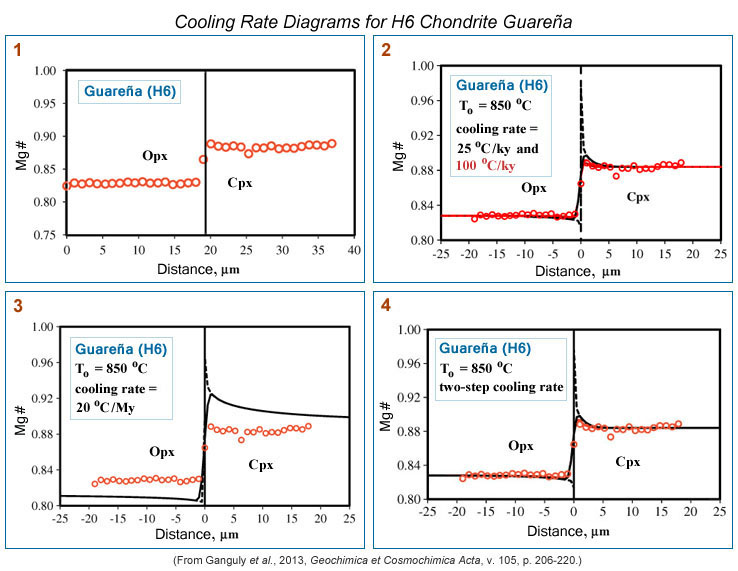 |
| Results from the study of chondrite cooling rates by Jibamitra Ganguly and his coworkers, keyed to the steps in the onion shell model for asteroid cooling (details in the text). This example is for one type 6 chondrite, Guareña. Step 1 [upper left graph] shows the compositional data obtained by electron microprobe analyses (open red circles). These analyses appear on the subsequent diagrams. Step 2 shows fits to two cooling-rate calculations, based on diffusion equations and published experimental determinations of diffusion rates in pyroxenes. The idea is to match the calculated compositional data to the observed data. A complication arises because microprobe data points come from a finite volume, so the apparent composition in one mineral is affected by the composition of the adjacent mineral very close to the boundary. Using a mathematical technique he developed previously, Ganguly accounted for this spatial averaging (also called convolution effect). The dashed line shows the calculated compositional profile for a prescribed (color coded) cooling rate and the solid line shows the corresponding convolved profile as it would appear in the microprobe data. A cooling rate of 100 oC per thousand years matches the data. Step 3 shows the complete mismatch between a slow cooling rate of 20 oC per million years, consistent with thermal models of cooling deep inside an asteroid 100 kilometers in diameter, and in the range determined by chemical zoning in metallic minerals in chondrites. The metallographic cooling rates record iron and nickel exchange at about 500 oC. The impressive mismatch shows that cooling at high temperature, where the chemical exchange between pyroxene crystals took place, could not have been as slow as it was at low temperature (500 oC) where the metallic minerals exchanged iron and nickel. Step 4 shows the good match for a two-stage cooling process, a fast one at high temperature (850 oC, 100 oC per thousand years) followed by a slow one at 700 oC (15 oC per million years). |
Step 3: Compare to compositional profiles for cooling rates expected for cooling in asteroid interiors. Calculations of cooling rates in asteroids larger than tens of kilometers across are much slower than the cooling rates Ganguly and colleagues determined for minerals with high closure temperatures. This is confirmed by cooling rates determined from iron and nickel variations in metallic minerals in chondrites, most of which fall in the range of 10-100 oC/million years, about a thousand times slower than those determined from the silicate and oxide thermometers used by Ganguly and colleagues. Because of faster diffusion in metallic minerals, chemical variations develop at a lower temperature than for the silicate and oxide minerals. To test whether a single cooling rate equal to the quite sluggish ones determined by metal grains could apply to the two pyroxene, orthopyroxene-spinel, or olivine-spinel pairs, Ganguly calculated the profiles expected for slow cooling from high temperature. For the example of Guareña, cooling at 20 oC/million years produces a vastly different compositional profile than the one measured in the meteorite. The large disparity between the measured and calculated compositional profiles is unequivocal evidence that Guareña could not have cooled from 850 o at a cooling rate of 20 oC/million years. Cooling was much faster at high temperatures.
Step 4: Test for multi-stage cooling. Having confidence in the quantitative methods of determining cooling rates of appropriate pairs of minerals, Ganguly and colleagues suggest that the meteorites they studied must have experienced a two-stage (or even multi-stage) cooling history. They tested this idea by calculating the integrated compositional profile for Guareña minerals: A fast one ( 100 oC per thousand years) at 850 oC, a transitional period between 750 and 650 oC, and the slow cooling at 15 oC per million years. Similar results apply to other meteorites studied (see diagram below), although Ganguly and coworkers show that one of the cases they studied, the type 4 chondrite Forest Vale, could have had a one-stage cooling history.
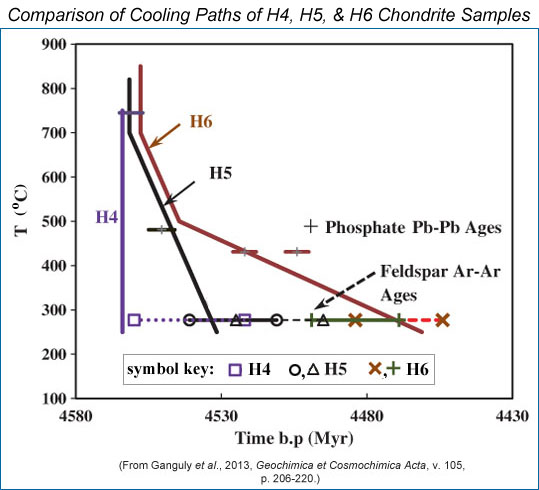 |
| This temperature versus time graph shows the cooling paths derived by integrated cooling rates at higher and lower temperatures with ages and the appropriate closure temperatures. The H4 sample is Forest Vale, H5 samples are Allegan and Richardton, and H6 samples are Guareña and Kernouvé. The diagram shows that the best fits to the entire ensemble of data involve cooling in one, two, or even three stages, indicating a complicated physical history of the H-chondrite parent asteroid. |
How to Discombobulate an Onion
If chondrite parent asteroids were heated by the internal decay of short-lived 26Al and the aluminum was distributed uniformly, the temperature gradient must have been like that predicted by thermal calculations. It is unavoidable. The question is whether the parent asteroids cooled completely, or at least to temperatures below the lowest closure temperature, before being disrupted to liberate all the samples of slowly-cooled meteorites in our collections. Why disrupted? We have numerous samples of H-chondrites that are composed of fragments of H-chondrites. We know that those breccias formed from rock fragments that resided on the parent body because of the presence of solar-wind gases in them. Finally, we know that the rock fragments cooled at rates equivalent to depths of a few kilometers to tens of kilometers. To end up with a surface debris pile containing chunks for rock from practically the entire body requires disruption and then reassembly of the parent body.
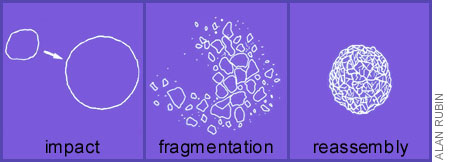 |
| Theoretical studies of the evolution of asteroids by impacts indicate that for a large range in impact energies, the bodies break up, but the fragments do not move apart fast enough to escape each other. Their mutual gravity causes the fragments to drift back together into a mixed-up, fragmental body. If this happened during chondrite heating or early in its cooling history, the body would be disrupted into a collection of countless hot fragments glowing red to orange. Some fragments would cool rapidly, though not necessarily completely, whereas others would not cool much because the fragments were large. After reassembling, individual fragments would cool corresponding to where they ended up inside the second-generation body. This disconnects the initial temperature from the subsequent slow cooling. Considering that adjacent fragments could have quite different temperatures, some would heat up, others cool down, before reaching an average temperature and then cooling. This view of disrupted and reassembled onion-shell parent asteroids predicts a wide range of cooling rates at different temperatures and a lack of correlation between cooling rate and petrographic type. |
If an asteroid was heated internally and began to cool, it would develop a temperature gradient as predicted by the onion shell model. If nothing happen to mix up this body, it will cool until it reaches a fairly low temperature and cooling rates of meteorites will show a correlation between the degree of metamorphism (petrographic type) and cooling rate. On the other hand, if onion-shell cooling is interrupted by an impact big enough to disrupt the body, the correlation between cooling rate and petrographic type would be messed up, as we seem to observe. When rocks are fragmented, about half the mass typically ends up in one or a few fragments, with the rest distributed over a huge range of fragment sizes. The fragments would cool according to their size and their proximity in the debris cloud to other hotter and cooler fragments, then slowly accrete into a new, more complicated body.
This complicated geological history should be apparent in the meteorite record. Some fragments (which we sample as meteorites) should have cooled faster from their pre-disruption temperatures than others, some fragments might show a correlation between petrographic type and cooling rates, whereas others will not show such a correlation. Some meteorites ought to have slow cooling rates from high peak temperatures as well as at low temperature. It is possible to test these possibilities from additional detailed studies of chondrites and their cooling rates, using all available mineral thermometers.
These are important tests. They lead to deciding between two views of a portion of the early Solar System history. In one view, asteroid-sized planetesimals accreted, probably rapidly, early in Solar System history when 26Al was still around (its half-life is only 730,000 years), but then were not assaulted by other objects until they cooled, a process that would have taken up to 100 million years. In the other, more chaotic view, a rapidly accreted body was soon disrupted. Impacts completely and permanently disassembled some of those bodies. Impacts were not so destructive on other bodies, breaking them up into countless fragments but not dispersing the pieces so far apart that they never met again. Instead, their mutual gravitational attraction allowed them to gently reassemble.
- PSRDpresents: New Martian Meteorite is Similar to Typical Martian Crust --Short Slide Summary (with accompanying notes).
- Ganguly, Jibamitra, Massimiliano Tirone, Sumit Chakraborty, and Kenneth Domanik (2013) H-Chondrite parent asteroid: A multistage cooling, fragmentation, and re-accretion history constrained by thermometric studies, diffusion kinetic modeling and geochronological data. Geochimica et Cosmochimica Acta, v. 105, p. 206-220, doi: 10.1016/j.gca.2012.11.024. [ abstract ]
- Ganguly, Jibamitra, Rabi N. Bhattacharya, and Sumit Chakraborty (1988) Convolution Effect in the Determination of Compositional Profiles and Diffusion Coefficients by Microprobe Step Scans. American Mineralogist, v. 73, p. 901-909. [ abstract ]
- Taylor, G. J. (Nov 2009) An Even More Precise View of Aluminum-26 in the Solar Nebula. Planetary Science Research Discoveries. http://www.psrd.hawaii.edu/Nov09/Al-26-distribution.html .
- Taylor, G. J. (July 2008) Heating, Cooling, and Cratering: One Asteroid's Complicated Story. Planetary Science Research Discoveries. http://www.psrd.hawaii.edu/July08/H-chondrite-parent.html.
|
|
[ About PSRD | Archive | CosmoSparks | Search | Subscribe ] [ Glossary | General Resources | Comments | Top of page ] |
